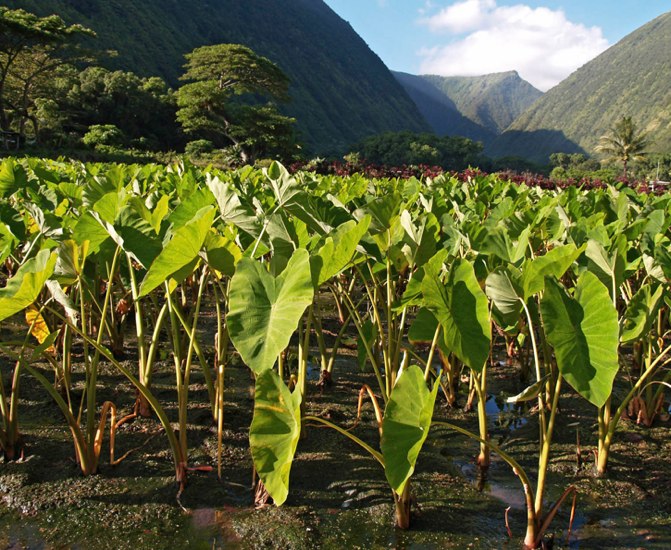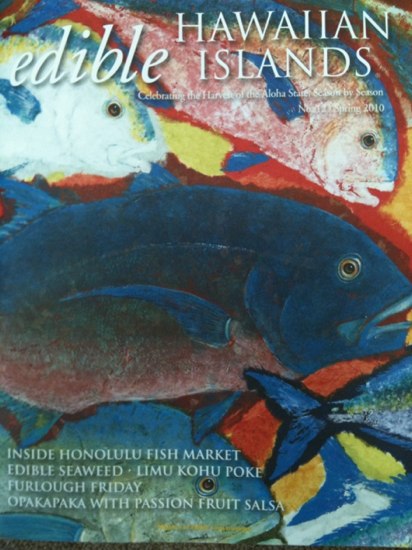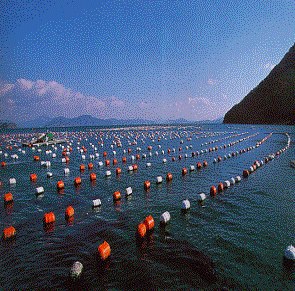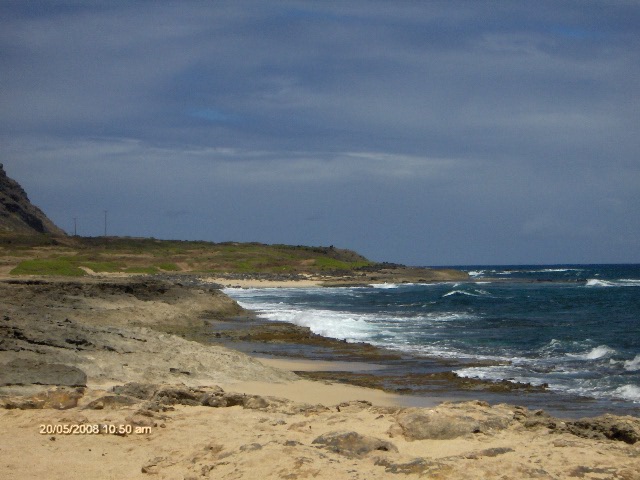Blog
News, updates, finds, stories, and tidbits from staff and community members at KAHEA. Got something to share? Email us at: kahea-alliance@hawaii.rr.com.
- A brief history of NFU/HFU
- What HFU can do for you
- What you can do for HFU=Join! Farmers & Friends are welcome!
- An invitation for agricultural leaders to join the core group of the Kauai Chapter
- An invitation for one of our farmers to fill the vacant seat on the Board of Directors
Come Talkstory - Shoreline Fishing Issues at Ka‘ena - June 27th
On Sunday June 27th starting at about 2:00 pm, fishers and ‘ohana will be gathering in Waiawa to discuss issues surrounding the management of Ka‘ena Point on O‘ahu. (Click to see map)
Located at the most northwest point of O‘ahu, Ka‘ena is one of the last relatively wild shorelines left on the island. It is a beloved fishing spot for many families, a spiritual pathway into the afterlife, and a refuge for endangered birds.
Its extreme weather and remote location helped to limit development, though it has suffered its share of urban burdens, including train tracks, military training, and most recently mud-bogging and uncontrolled bonfires.
As you may already know, Ka‘ena has been the focus of many regulatory attempts over the years. Most of these past efforts have met with failure due to lack of community support. Here is a link to the long list of abandoned management schemes at Ka‘ena.
With a brand of tenacity unique to state government, once again, the community faces a new management plan developed by staff at the Department of Land and Natural Resources with only selected input from community members. The state needs a new management plan because Ka‘ena will likely be highlighted as one of O‘ahu’s wilderness camping areas under DLNR’s new “Recreational Renaissance.” Recreational Renaissance is just a nifty name for another scheme to raise money from the use of state land in a wide range of not-always-compatible ways, including the collection various permit and entry fees to state parks. A draft of the state’s plan for Ka‘ena will be open for general public comment at a hearing in late July.
In anticipation of this meeting and in response to many complaints about state management, shoreline fishers from around O‘ahu are gathering at a farm in Waiawa on June 27th to talk about the many issues facing this community. The recent trend in harassment of fishers by DLNR enforcement officers and HPD has led many to forego fishing the way their families have for generations. This is related to current state regulations that limit the longstanding practice of over-night fishing and current proposals to impose new permitting requirements on shoreline fishers. Click here to visit a blog specific to Ka‘ena management issues.
This is a tough issue to grapple with. For me, I think the disconnect was said best by one lifelong fisherman from Waipahu:
“Why you imposing fees on me, when I only can catch enough to feed my family, but you do nothing, nothing to prevent the massive fish takes by these commercial guys, who come in here just when the fish start to run and take the whole school one time?”
If you are interested in learning more about shoreline fishing issues on O‘ahu and want to connect with the local fishing community, please contact Summer at 753-4221/ culturalpractice@gmail.com to RSVP for the public meeting on June 27th at 2pm in Waiawa. She asks that you bring own chairs.
Preliminary Victory in Long Battle to Save Farmland
From Marti:
The first preliminary hearing in the whole purple spot saga was held on May 20th before the Land Use Commission. The Land Use Commission met to decide whether the Environmental Impact Statement is complete for Tropic Land’s proposal to turn 96 acres of fertile farm land into an industrial park at the back of Lualualei Valley (the industrial park is the purple spot).
All six commissioners present agreed that the EIS is complete, but some of them made clear that based on the public testimony presented they had serious concerns about the proposal itself.
Testimony presented to the Land Use Commission alleged that Tropic Land, LLC is operating an unauthorized truck baseyard on agricultural land and has illegally mined pohaku from a known ancient Hawaiian cultural site.
“At least 85% of the farmland has been covered with asphalt,” said one eye-witness.
Activities like storage of trucks, and vehicle repair and maintenance are not allowed on land zoned for agricultural use. Waianae Coast residents said they filed complaints with both the Department of Land and Natural Resources’ Enforcement Branch and the City and County of Honolulu.
Tropic Land, LLC has been cited on at least three other occasions for engaging in activities on the Lualualei property that were not consistent with its agricultural classification.
Pictures also documented the mining of stones on preservation land adjoining the Tropic Land parcel. Cultural surveys conducted on the parcel in the 1990’s confirm that this stones comprised a substantial, culturally significant platform.
A Nanakuli resident testified that ¾ of the substantial stone platform had been removed and some of the stones were used to make a sacred place to reinter Hawaiian burials exhumed by Wal-Mart on Keaaumoku Street. Tropic Land, LLC did not have authorization from the State Historic Preservation Division to remove stones from this site.
Tropic Land, LLC was before the Land Use Commission to change the classification of their Lualualei Valley property from agricultural to urban, in order to allow them to construct an industrial park on the property.
The Land Use Commission accepted Tropic Land, LLC’s final environmental impact statement for the industrial park proposal, but not before voicing concerns about the testimony presented by the public.
Holding up a picture of trucks parked behind a fence on the Tropic Land parcel, Commissioner Contrades asked Tropic Land’s attorney William Yuen, “is this correct?” Mr. Yuen said he had not seen the photograph, but that the property is not paved and trucks are not being stored on the property at this time.
Commissioner Wong asked Yuen a series of questions to clarify that acceptance of the EIS did not in anyway demonstrate support for or ensure approval of the project.
Commissioner Teves requested that the Commission perform a site visit to “see the so-called commercial use of the property in its present form, to see if it is true or not.”
What does this mean for the future of the purple spot?
It means that the formal one-year process to decide whether to rezone this part of Lualualei Valley from ag to urban has started. The hearing on the actual rezoning decision will be held on September 9, 2010 at 9:30 before the Land Use Commission.
It also means that the developer will have a very hard time arguing that this industrial park proposal is consistent with Waianae’s Community Sustainability Plan, since the current has no purple spot allowing for industrialization of this area… and the amended one with the purple spot has not been adopted by the Honolulu City Council. In fact, staff at the city said they don’t expect the Waianae Community Sustainability Plan to come before the Council the Fall of 2010.
Kauai Farmer's Union Invite

From our friends at the Hawai’i Farmer’s Union:
All FARMERS and FRIENDS of farmers are invited to the next meeting of the Kauai Chapter of HFU, on Monday, May 24, 2010, from 7-9 pm, at the Lihue Neighborhood Center, on Eono Street. We will have a featured speaker on the water issues on Kauai, plus additional topics to be presented:
For more info call Patti Valentine at 652-0433, or email us: HFUKauai@gmail.com. Additional meetings are planned around the island this summer and winter.
Our mission: Hawaii Farmers Union advances the rights of farmers to create vibrant and prosperous agricultural communities for the benefit of all through cooperation, legislation, and education.
Greed for Feed: Connecting the Dots
Today, Hawai’i is looking at a proposed new offshore ahi tuna farm–the very first ever to be approved for waters under U.S. jurisdiction. Of course, to raise fish that eat fish (carnivorous fish), you need… fish. Fish like anchovies, generally taken from fisheries around the global south, particularly Central and South America.
The fact that a significant amount of the fish caught on this planet goes to make fish meal (for feeding fish and other farmed livestock) is a growing concern for world health and food security (Global and Regional Food Consumption Patterns and Trends, World Health Organization, Section 3.5).
The 247-acre operation proposed for Hawai’i, to be run by Hawaii Ocean Technology, Inc., will require 12,000 tons of fish feed annually, at full operation (according to its own EIS, prepared by Tetratech).
This short movie–”The Greed for Feed”–is testament to some of the impacts that fish feed harvesting has had on coastal Peruvian communities.
When we talk about aquaculture and “food security” in Hawai’i… is this what we mean?
Reading: Edible Hawaiian Islands

This issue of Edible Hawaiian Islands is devoted to fish, fishing, and fisheries. How fish gets from the sea to your plate, and everything in between.
Some interesting ideas on the future for “sustainable” fisheries by Jon Letman, and on raising fish “Loko” style by Rob Parsons.
We’re liking: Rob’s interview with Michael Kumuhauoha Lee, of the ‘Ewa Beach Limu Restoration Project–
Lee believes that modern Western aquaculture systems run into difficulties by trying to maximize dollar output, and by not looking at how true natural resource systems of abundance are created. “It is the Hawaiian belief,” says Lee, “that everything is a living being. The outer fishpond rock walls are like the skin–they are porous and allow zoo-plankton to pass through. Plankton and algae are among the most basic life forms.
“The fresh-water springs are like a circulatory system,” says Lee. “It is essential to set up a diverse biosphere, and to plant and seed the limu to attract the fish into the pond. Don’t disregard the vitality of the elemental systems, the safeguards and the knowledge that is already here.”
April Round-up on Pono Aquaculture
Mahalo to Rob Parsons (our amazing Food and Water Watch Hawaiʻi Outreach Coordinator and our friend and fellow member of the Pono Aquaculture Alliance) for this April round-up on efforts towards sustainable, pono aquaculture in Hawai’i:
The month of April has been full-tilt on the forefront of aquaculture issues in Hawaii, and beyond. We announced the formation of the Pono Aquaculture Alliance, broadened the scope of our outreach, and got a good deal of press coverage (see links below).
We gave presentations at UH-Maui College, UH-Manoa, Kawaihae, and in mauka Kona, taped an AKAKU public access TV show with Elle Cochran on Maui, did a two-hour radio show with Brickwood Galuteria, held a press conference at the capital, talked with legislators, and met candidates Neil Abercrombie and Gary Hooser at a Dem party function. We also met with Walter Ritte and Noelani Lee Yamashita on Molokai, and see their fishpond restoration efforts, and met with Ed Cichon of Maui Fresh Fish, LLC, who hopes to raise opakapaka in cages off Lanai. Yesterday was the NOAA regional “listening session” to accept input on NOAA’s efforts to draft a “sustainable ocean aquaculture” policy.
What a month! From us at KAHEA, mahalo pumehana to all those who are giving of their time, efforts, and mana’o on this issue–for their passionate care for our ocean, Hawaiian waters, Hawaiian fish, food sovereignty & security, and the aloha ‘āina that powers this movement.
TV and newspaper links:
Andrew Gomes/ Honolulu Advertiser on PAA press conference
http://www.honoluluadvertiser.com/article/20100409/BUSINESS/4090332/Group+urges+fish-farming+safeguards
Coalition champions sustainable fish production in Hawaii
http://www.hawaii247.org/2010/04/09/coalition-champions-sustainable-fish-production-in-hawaii/
Coalition alleges fish farms hurt land
By Gene Park HONOLULU STAR-BULLETIN
http://www.starbulletin.com/business/20100409_Coalition_alleges_fish_farms_hurt_land.html
Is There an Open Season on Open Ocean Aquaculture?
Reported by: Ron Mizutani/ KHON Channel 2
http://www.khon2.com/content/news/developingstories/story/Is-There-an-Open-Season-on-Open-Ocean-Aquaculture/asLsjbbXBUSQH84WJdKZEQ.cspx
Residents voice concerns over aquaculture project
by Chelsea Jensen/ West Hawaii Today
Saturday, April 10, 2010 7:17 AM HST
http://www.westhawaiitoday.com/articles/2010/04/10/local/local02.prt
Net pen in harbor draws investigation
by Carolyn Lucas/ West Hawaii Today
Wednesday, April 7, 2010 9:30 AM HST
http://www.westhawaiitoday.com/articles/2010/04/07/local/local04.txt
Community questions fish farms
By Hadley Catalano/ Big Island Weekly
Wednesday, April 14, 2010 9:59 AM HST
http://www.bigislandweekly.com/articles/2010/04/14/read/news/news08.txt
Fish farm frenzy
Watchdog group releases report criticizing open aquaculture in Hawai‘i
SEAMUS HOGG/HONOLULU WEEKLY
APR 14, 2010
http://honoluluweekly.com/feature/2010/04/fish-farm-frenzy/
Coalition knocks nascent Hawaii industry
By Denise Recalde
editorial@fis.com/ www.fis.com
http://fis.com/fis/worldnews/worldnews.asp?monthyear=&day=12&id=36169&l=e&special=&ndb=1%20target=
Report Blasts Hawaii Aquaculture
Environmental Group Claims Fish Farming Not Environmentally Sustainable
Dick Allgire KITV 4 News Reporter
POSTED: 2:48 pm HST April 8, 2010
http://www.kitv.com/news/23096058/detail.html
NOAA "Listening Session" Report-back

Mahalo to Rob Parsons, long-time Maui resident, journalist, and local environmental advocate for his detailed report-back on the Honolulu NOAA “listening session” yesterday. The post below is from his notes on the meeting:
Yesterday’s NOAA listening session was one of six being held nationwide to solicit input as NOAA strives to establish a policy for “sustainable ocean aquaculture.” About 80 people showed up at the second floor of the Ala Moana Hotel, a block from the Hawaii Convention Center and Ala Moana Shopping Center, for the 2 1/2 hour meeting.
It is clear that the word went out to those in the industry, and associated with UH, the Oceanic Institute, and the Hawaii Aquaculture Association. Fortunately, even given the fact that the meeting was in Honolulu only (no provisions for participation by those on neighbor islands) and in the middle of a workday, we had a decent showing from members of the Pono Aquaculture Alliance, and conservation groups.
The session was facilitated by Andy Winer, who headed the Hawaii Obama presidential campaign and is now a political appointee to NOAA. I spoke with him afterwards; he said this is very preliminary and very wide open, just asking input for now, He said when they come forward with a draft policy (he mentioned 4 months, but I think that is ambitious) he said things will be much more serious. He spoke of their goal: “To implement a new sustainable aquaculture policy.” “The policy components are that it be science-based, eco-system focused, promote innovation, and that there be a clear and efficient management system. The big question is, What will be NOAA’s role?”
He also mentioned the importance of production, restoration, and enhancement. Also jobs and socio-economic factors. He also said this should look at how it fits with other NOAA programs.
After his intro, Dr. Jo Ann Leong of Hawaii Institute of Marine Biology gave a pro-OOA Powerpoint. Said there is no way historic fishponds can provide enough fish. Said Hawaii 20250 Sustainability Plan supports this, and that we should “create a sustainability ethic.” We’re way behind China and Norway in sales. ($34.7M in 2008….mostly in algae nutraceuticals, not finfish, I’d guess). Mentioned challenges.
NOTE: Keynote speaker Dr. Leong is on the board for Hawaii Oceanic Technology, a company currently proposing a massive ahi feedlot off the coast of the Big Island. Is this a bit too cozy a relationship? Is this pono?
Overall, about 20 people spoke in favor of supporting open ocean aquaculture, and 10 of us expressed concerns and cautions:
Strongly Pro-OOA
1) Dave Takaki (?) “resurrecting fishponds is not economically feasible, and is virtually insurmountable”
2) Dr. Tetsuzan “Benny” Ron, UH Aquaculture Prog. Coord. – “building a sustainable future….all should support this”
3) Todd Low, Mgr. Aquaculture Dev’t Prog., Dept of Ag- “diversify economy, food self-sufficiency. HI sets the standards”
4) John Corbin, consultant (former director ADP) “Farming in the EEZs puts food on tables.” “We have BMPs.”
5) Todd Hendrix, retired science teacher- uses Cousteau 1973 quote (!). “HI oceans are nutrient poor and this helps.”
6) Ron Weidenbach, Pres. HI Aqua Assoc.- supports “truthful presentation based on science” wants increased R&D.
7) Tony Ostrowski, Pres. Oceanic Institute- said their mission is to secure a seafood source (for consumption) HOWEVER, their website give the following mission statement: The mission of the Ocean Institute is to inspire all generations, through education, to become responsible stewards of our oceans.
8. Steven Von Kampen Louis, young, student, in favor.
9) Brian Miyamoto, Hawaii Farm Bureau Federation- “Huge opportunity. Should be able to develop safe practices.”
10) Dr. Steven Dollar, does water monitoring for Hukilau et al- “Problems don’t exist here.”
11) Michael Berman- “spend time listening to the people who are in the (aquaculture) field.”
12) Ronnie Nasuti (?), exec chef, Roy’s- “Can’t talk about science or politics—I cook. People love eating the moi.”
13) Norman Nong (?), Cinnamon’s restaurant- “can’t afford local fish on our menu” “I’m for aquaculture, of course.”
14) Clyde Tamaru, UH-CTAHR (former UH-Sea Grant)- Used the sea horse farm at NELHA as an example. (!)
15) Kimokeo Kapahulehua, pres. Fishpond assoc on Maui- “Keep the culture intact.” Then in his last 30 seconds he
said we should support Maui Fresh Fish LLC’s plan to raise opakapaka off Lanai. (he is their hired consultant).
16) Sean Martin, WESPAC- Support HB 4363, etc. Magnuson-Stevens act defines OOA as a “fishery.”
17) Bill Spencer, CEO HOT and HVCA- (waited until last to speak) “I’m the only one in the US who has been given the
permit for a tuna farm. I’m proud to be for-profit and make money for my investors. We are environmentally
responsible and economically sustainable. Hawaii is the perfect model to follow for permitting. The permit process
has consumed more than one third of our investment capital to date.”
Support with Conditions:
18) Steve Chaiken, HAA, Molokai Sea Farms- Has 22 earthen ponds w/ fish, shrimp, seaweed. “Very expensive to simulate the ocean on land.” “Some say we shouldn’t use the Pacific Ocean to raise fish—I share some of those concerns.” NOAA needs to partner for BMPs. “Gov’t isn’t good at planning carrying capacity. Look at Waikiki.” “Don’t let an asset turn into a liability.” “What we’ve done well here is research. Esp. disease mgmt.”
19) Glen Martinez, Olomana Gardens (Waimanalo)- “should have a mtg on Big Island—they have 22 aquaponic farms.”
20) Randy Cates, Hukilau Foods- After 10 years, I’m tired. Likes “balance” in the ocean. Donates fish to groups.
Not for OOA without stringent guidelines
22) Marti Townsend, KAHEA- “Hawaii is not your laboratory, its resources are not expendable.” NOAA could support fishpond restoration. “Use traditional knowledge.” Challenges the idea of ‘farming the ocean’ (Cousteau). “Plantation ag over the past century has been very harmful. Need more outreach. Only a 2-hour mtg, and at Ala Moana Hotel? Should be on the Big Island. You are limiting who will attend by holding it here.”
23) Trisha Kehaulani Watson, PhD.- Two points: Culture and community are missing. Ocean is also a cultural resource. It is both our church and our classroom. Community—Conflict is brewing here. Let state and local gov’ts come up with local solutions that are site-appropriate.
24) Rob Parsons, PAA, FWW et al- mainly read PAA criteria and unity statement. Asked that NOAA take a step back and ask whether a OOA policy should be developed, not how.
25) Dr. Neil Frazer, UH-“Would be sorry to see Hawaii and the U.S. Repeat the mistakes of my native British Columbia.”Should learn from the mistakes made in (mis-)mgmt of capture fisheries. Listed criteria for pono aquaculture.
26) Keiko Bonk, Marine Cons. Biol. Institute and Save Our Seals- “Questions about the ability to be a clean industry. We’d like to see a plan before allowing ventures to start up first. Especially for large-scale ventures. Large ag has ruined our land. Start small—large doesn’t work. What does sustainable mean? Long-term good, and minimal consequences. Too many factors don’t make sense as an industry.”
27) Dave Raney, Chair Sierra Club Marine Action Team- “Using mostly herbivorous fish is important. SC supports OOA only if it is truly sustainable and ecologically sound. NOAA should develop policy with specific criteria. Serious reservations about industrial scale operations.”
28) Linda Paul, Hawaii Audubon Society- Set enforceable national standards. OOA shouldn’t be substitute for re-stocking overfished stocks. Forage fish stocks are already fully exploited. Shouldn’t be substituted with soy because of naturally occurring estrogen.
29) Zuri “Z” Aki, UH student, “Support aquaculture, but I don’t support the current model of caged fish. Look into
getting communities into the ahupua`a (land-to-sea) model, not the corporate model.”
*KAHEA also submitted comments on behalf of Uncle Pilipo Souza and Uncle Isaac Harp.
Written comments may be submitted up until May 14th. Comments may be submitted through this link: http://www.nmfs.noaa.gov/aquaculture/policy1/comments.htm






